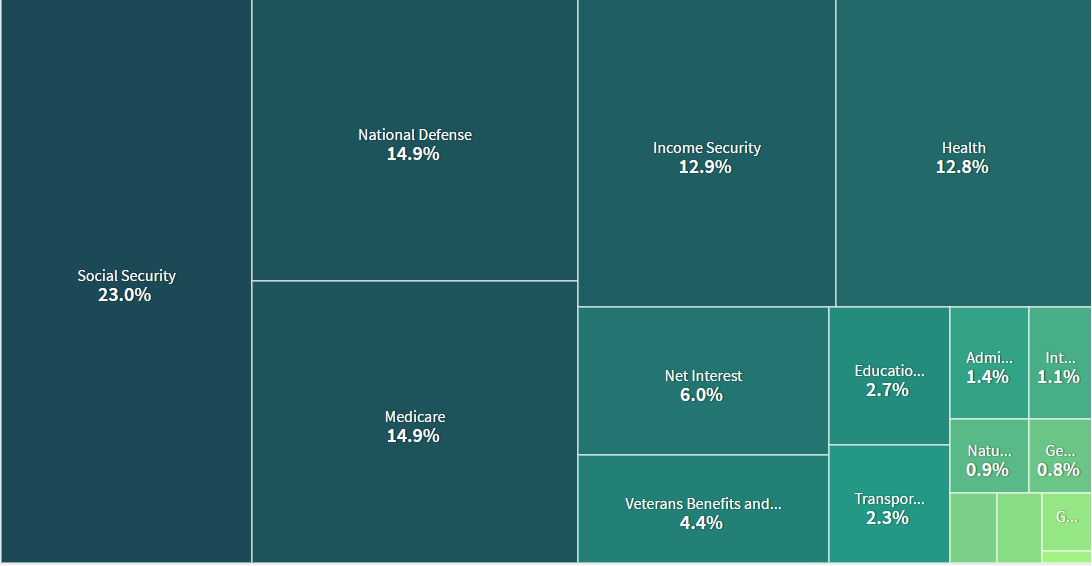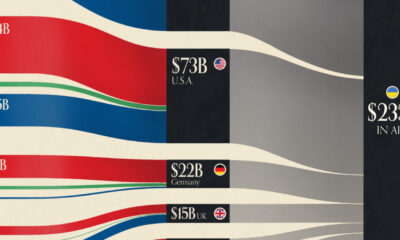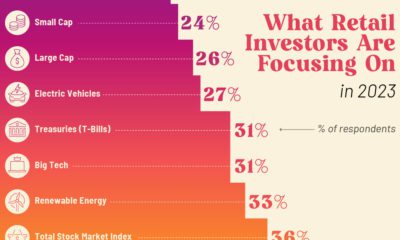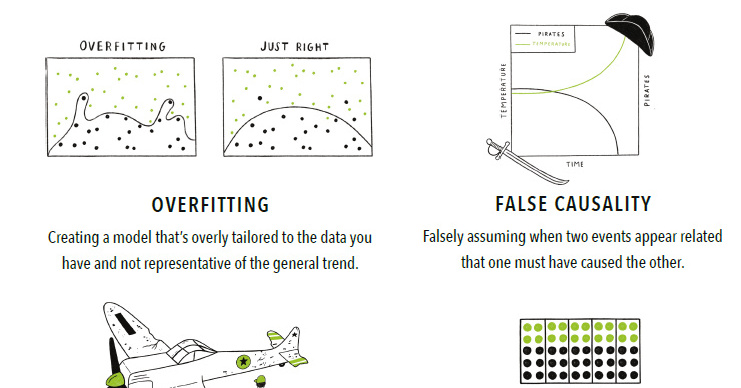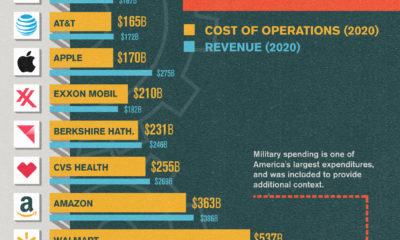Politics
U.S. Federal Government Spending is Now a Single, Unified Data Set
It’s been many years in the making, but spending data from the U.S. Federal Government is now all unified in one source that can be accessed by anyone.
The significance of this cannot be overstated – every single department of the government is now reporting data to the U.S. Treasury in a common format, and this information is being published online at USASpending.gov.
The data puts records of accounts, budgets, grants, and contracts all in one place, and links this information together in way that has never been done before. Everyday citizens, journalists, and data scientists will be able to see how the government spends money with one consolidated view. Further, this harmonization of accounts will also help to boost transparency, making it easier to spot inefficiencies, waste, and fraud at the federal level.
Here’s an example of a “big picture” output – a view of all 2016 spending in one easy chart.
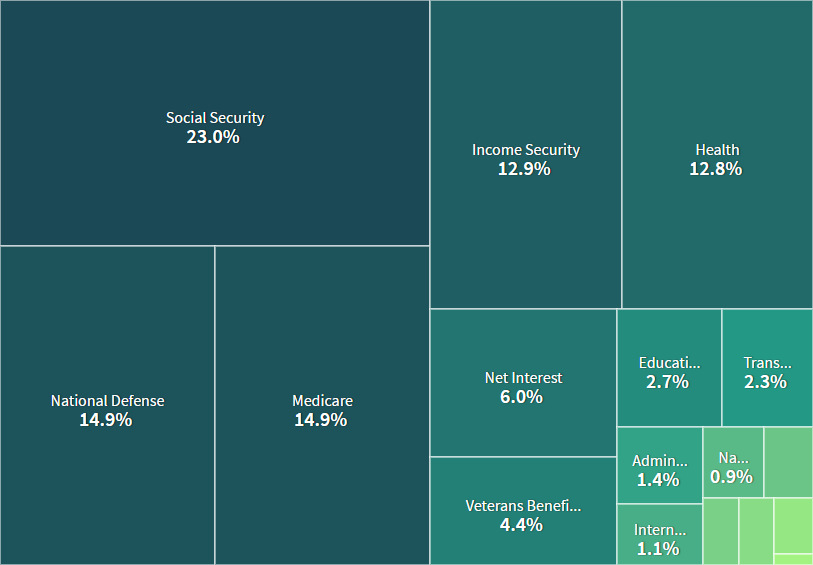
For the interactive version of the above chart that details $3.85 trillion of federal expenditures and what is included in each account, go to the USASpending.gov site. To dive deeper into millions of data points for each individual transaction record, you’ll probably want to access the API.
It’s Not Perfect, Yet
As with all large government projects, it’s probably not a surprise to learn that the project isn’t exactly working optimally yet. Upon mucking around on the site, certain maps are not yet generating, and the API site was down when we tried to access it:
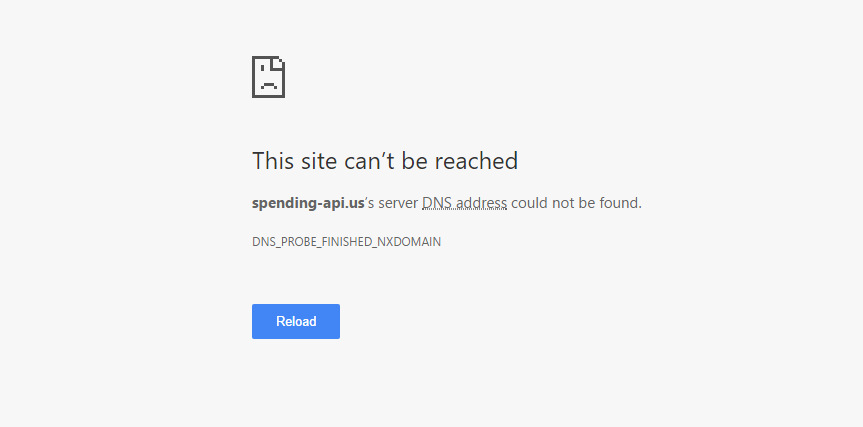
Part of the problem is that the DATA Act of 2014, which laid the groundwork for the initiative, had specified a deadline (May 9, 2017) for all agencies to be reporting data in a unified format. Obviously, harmonizing thousands of legacy financial reporting systems from dozens of federal departments is not an easy task.
Deloitte, in a joint report with the Data Coalition trade association, recognizes these technical challenges, while also outlining additional problems that must be addressed with the DATA Act and corresponding systems by 2022.
Jefferson’s Vision
Hudson Hollister, the Founder and Executive Director at Data Coalition, outlined the significance and challenges of harmonizing government data in a blog post today.
He also referenced something interesting, which is that this idea was outlined initially by Thomas Jefferson in the early 19th century. In fact, it was in 1802 that Jefferson wrote to his Treasury Secretary to tell him that the government’s finances were too convoluted for Congress to understand, and this complexity enabled debt and spending to spiral out of control.
His solution at the time? To harmonize all government expenditures in one place:
If to this can be added a simplification of the form of accounts in the treasury department, and in the organization of its officers, so as to bring everything to a single centre, we might hope to see the finances of the Union as clear and intelligible as a merchant’s books, so that every member of Congress, and every man of any mind in the Union, should be able to comprehend them, to investigate abuses, and consequently to control them.
– Thomas Jefferson, Library of Congress (1802)
Hollister notes that it is only now that Jefferson’s vision has been realized.
Hopefully, with some refinement and continued buy-in from government and industry stakeholders, this means more transparent government finances for the foreseeable future.
Economy
The Bloc Effect: International Trade with Geopolitical Allies on the Rise
Rising geopolitical tensions are shaping the future of international trade, but what is the effect on trading among G7 and BRICS countries?

The Bloc Effect: International Trade with Allies on the Rise
International trade has become increasingly fragmented over the last five years as countries have shifted to trading more with their geopolitical allies.
This graphic from The Hinrich Foundation, the first in a three-part series covering the future of trade, provides visual context to the growing divide in trade in G7 and pre-expansion BRICS countries, which are used as proxies for geopolitical blocs.
Trade Shifts in G7 and BRICS Countries
This analysis uses IMF data to examine differences in shares of exports within and between trading blocs from 2018 to 2023. For example, we looked at the percentage of China’s exports with other BRICS members as well as with G7 members to see how these proportions shifted in percentage points (pp) over time.
Countries traded nearly $270 billion more with allies in 2023 compared to 2018. This shift came at the expense of trade with rival blocs, which saw a decline of $314 billion.
Country Change in Exports Within Bloc (pp) Change in Exports With Other Bloc (pp)
🇮🇳 India 0.0 3.9
🇷🇺 Russia 0.7 -3.8
🇮🇹 Italy 0.8 -0.7
🇨🇦 Canada 0.9 -0.7
🇫🇷 France 1.0 -1.1
🇪🇺 EU 1.1 -1.5
🇩🇪 Germany 1.4 -2.1
🇿🇦 South Africa 1.5 1.5
🇺🇸 U.S. 1.6 -0.4
🇯🇵 Japan 2.0 -1.7
🇨🇳 China 2.1 -5.2
🇧🇷 Brazil 3.7 -3.3
🇬🇧 UK 10.2 0.5
All shifts reported are in percentage points. For example, the EU saw its share of exports to G7 countries rise from 74.3% in 2018 to 75.4% in 2023, which equates to a 1.1 percentage point increase.
The UK saw the largest uptick in trading with other countries within the G7 (+10.2 percentage points), namely the EU, as the post-Brexit trade slump to the region recovered.
Meanwhile, the U.S.-China trade dispute caused China’s share of exports to the G7 to fall by 5.2 percentage points from 2018 to 2023, the largest decline in our sample set. In fact, partly as a result of the conflict, the U.S. has by far the highest number of harmful tariffs in place.
The Russia-Ukraine War and ensuing sanctions by the West contributed to Russia’s share of exports to the G7 falling by 3.8 percentage points over the same timeframe.
India, South Africa, and the UK bucked the trend and continued to witness advances in exports with the opposing bloc.
Average Trade Shifts of G7 and BRICS Blocs
Though results varied significantly on a country-by-country basis, the broader trend towards favoring geopolitical allies in international trade is clear.
Bloc Change in Exports Within Bloc (pp) Change in Exports With Other Bloc (pp)
Average 2.1 -1.1
BRICS 1.6 -1.4
G7 incl. EU 2.4 -1.0
Overall, BRICS countries saw a larger shift away from exports with the other bloc, while for G7 countries the shift within their own bloc was more pronounced. This implies that though BRICS countries are trading less with the G7, they are relying more on trade partners outside their bloc to make up for the lost G7 share.
A Global Shift in International Trade and Geopolitical Proximity
The movement towards strengthening trade relations based on geopolitical proximity is a global trend.
The United Nations categorizes countries along a scale of geopolitical proximity based on UN voting records.
According to the organization’s analysis, international trade between geopolitically close countries rose from the first quarter of 2022 (when Russia first invaded Ukraine) to the third quarter of 2023 by over 6%. Conversely, trade with geopolitically distant countries declined.
The second piece in this series will explore China’s gradual move away from using the U.S. dollar in trade settlements.

Visit the Hinrich Foundation to learn more about the future of geopolitical trade

-

 Economy2 days ago
Economy2 days agoEconomic Growth Forecasts for G7 and BRICS Countries in 2024
The IMF has released its economic growth forecasts for 2024. How do the G7 and BRICS countries compare?
-

 United States2 weeks ago
United States2 weeks agoRanked: The Largest U.S. Corporations by Number of Employees
We visualized the top U.S. companies by employees, revealing the massive scale of retailers like Walmart, Target, and Home Depot.
-

 Economy2 weeks ago
Economy2 weeks agoWhere U.S. Inflation Hit the Hardest in March 2024
We visualized product categories that saw the highest % increase in price due to U.S. inflation as of March 2024.
-

 Economy1 month ago
Economy1 month agoG20 Inflation Rates: Feb 2024 vs COVID Peak
We visualize inflation rates across G20 countries as of Feb 2024, in the context of their COVID-19 pandemic peak.
-

 Economy1 month ago
Economy1 month agoMapped: Unemployment Claims by State
This visual heatmap of unemployment claims by state highlights New York, California, and Alaska leading the country by a wide margin.
-

 Economy2 months ago
Economy2 months agoConfidence in the Global Economy, by Country
Will the global economy be stronger in 2024 than in 2023?
-

 Misc1 week ago
Misc1 week agoHow Hard Is It to Get Into an Ivy League School?
-

 Technology2 weeks ago
Technology2 weeks agoRanked: Semiconductor Companies by Industry Revenue Share
-

 Markets2 weeks ago
Markets2 weeks agoRanked: The World’s Top Flight Routes, by Revenue
-

 Countries2 weeks ago
Countries2 weeks agoPopulation Projections: The World’s 6 Largest Countries in 2075
-

 Markets2 weeks ago
Markets2 weeks agoThe Top 10 States by Real GDP Growth in 2023
-

 Demographics2 weeks ago
Demographics2 weeks agoThe Smallest Gender Wage Gaps in OECD Countries
-

 Economy2 weeks ago
Economy2 weeks agoWhere U.S. Inflation Hit the Hardest in March 2024
-

 Green2 weeks ago
Green2 weeks agoTop Countries By Forest Growth Since 2001

